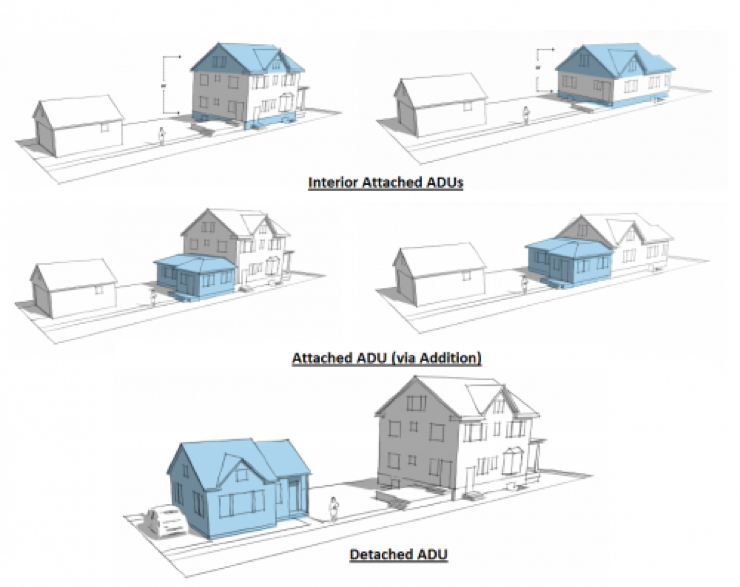DC now allows accessory apartments to be built in residential zones. What happens next?

DC's residential zones may soon be home to smaller units. Image by Jean Flanagan licensed under Creative Commons.
Last year, the DC Zoning Commission adopted a new zoning code. In addition to simplifying the regulations and adapting them to DC’s current context, the 2016 changes included significant policy reforms.
One of these reforms was a provision that allowed for the by-right development of Accessory Apartments (also commonly known as Accessory Dwelling Units, or ADUs) in certain residential zones in the city.
This is important, because these accessory apartments can contribute significant benefits to individuals, neighborhoods, and the city.
What is an accessory apartment?
An accessory apartment is a secondary dwelling unit established in conjunction with and clearly subordinate to a primary dwelling unit. It could be a part of the same structure as the primary dwelling unit or a detached dwelling unit on the same lot. These units might be an addition to a garage, an entirely new structure, or a basement or attic apartment in the existing single-family house. Here are some examples: Image by City of St. Paul.

DC’s new zoning code allows the development of an accessory apartment as a matter-of-right in almost all residential (R) zones (zones R-19 and R-20 are the exception). This means that homeowners in the R zones can construct an accessory apartment without needing special permission to do so.
Before the 2016 revision, accessory apartments in these zones were highly restricted, and were subject to approval from the Board of Zoning Adjustment. The new zoning code removes significant barriers and increases the potential for accessory apartments to benefit the city. The areas shown in yellow are residential (or R) zones, where accessory apartments can now be built without special permission. Image by DC Office of Zoning.

Why are accessory apartments important?
Accessory apartments have the potential to contribute many housing-related benefits in DC. Among other things, these units can increase the supply of affordable housing without government subsidies, can create opportunities for multi-generational households to form, and can diversify neighborhoods in terms of housing stock and households. I wrote more about this, and examples of other cities that have benefitted from accessory apartment development, in a paper that was published last year.
As for housing affordability, accessory apartments present an opportunity to increase the supply of housing, which could in turn reduce housing prices. To be clear, absent additional incentives or regulations, the units that are developed as a result of the zoning change will not be “designated” (i.e. income restricted) affordable housing, rather they may contribute to housing affordability by increasing the stock of housing available in previously restricted locations.
In addition, accessory apartments can help homeowners offset the cost of housing by producing rental revenue, and can in turn provide a more affordable housing option for renters looking to rent in an established neighborhood with access to amenities that might otherwise be inaccessible because of housing costs.
Further, many homeowners may find that accessory apartments provide an opportunity to form a multigenerational household. Multigenerational housing has become an attractive option for households seeking to accommodate aging parents and adult children. By providing a separate but proximate housing unit, located on land which a homeowner already owns, an accessory apartment can allow families to retain a semi-independent living situation in a way that is both affordable and accessible.
However, in order for accessory apartments to produce these benefits, they must first be built.
What happens now?
The 2016 zoning change was an important and critical step in progress towards the production of accessory apartments in DC. Now that DC’s zoning regulations allow for the by-right development of these units, they have the potential to be part of a broader strategy that increases access to housing in the District. However, barriers to accessory apartment development still remain. These barriers include access to information, processes, and financing, among other things.
The good news is that there are people who are actively working to identify and solve these problems. As part of an ongoing effort to ramp up the production of accessory apartments in the District, the Coalition for Smarter Growth and the newly formed DC Accessory Apartment Workgroup is hosting a day-long workshop October 23 on accessory apartments, with DC AIA and ULI Washington sponsoring.
Participants will learn more about DC’s new zoning code as it relates to accessory apartments, hear from experts who have implemented successful ADU development programs in Portland, Oregon, and discuss potential design and financing methods for accessory apartment development in DC. You can sign up here.
